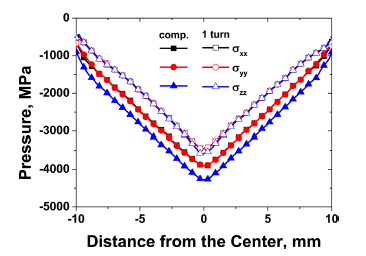- [Korean]
- Effect of Support Structure on Residual Stress Distribution in Ti-6Al-4V Alloy Fabricated by Laser Powder Bed Fusion
-
Seungyeon Lee, Haeum Park, Min Jae Baek, Dong Jun Lee, Jae Wung Bae, Ji-Hun Yu, Jeong Min Park
-
J Powder Mater. 2025;32(3):244-253. Published online June 30, 2025
-
DOI: https://doi.org/10.4150/jpm.2025.00087
-
-
 Abstract Abstract
 PDF PDF
- Ti-6Al-4V alloy is widely utilized in aerospace and medical sectors due to its high specific strength, corrosion resistance, and biocompatibility. However, its low machinability makes it difficult to manufacture complex-shaped products. Advancements in additive manufacturing have focused on producing high-performance, complex components using the laser powder bed fusion (LPBF) process, which is a specialized technique for customized geometries. The LPBF process exposes materials to extreme thermal conditions and rapid cooling rates, leading to residual stresses within the parts. These stresses are intensified by variations in the thermal history across regions of the component. These variations result in differences in microstructure and mechanical properties, causing distortion. Although support structure design has been researched to minimize residual stress, few studies have conducted quantitative analyses of stress variations due to different support designs. This study investigated changes in the residual stress and mechanical properties of Ti-6Al-4V alloy fabricated using LPBF, focusing on support structure design.
- [Korean]
- Analyses of Densification and Consolidation of Copper Powders during High-Pressure Torsion Process Using Finite Element Method
-
Dong Jun Lee, Eun Yoo Yoon
-
J Korean Powder Metall Inst. 2015;22(1):6-9. Published online February 1, 2015
-
DOI: https://doi.org/10.4150/KPMI.2015.22.1.6
-
-
654
View
-
2
Download
-
1
Citations
-
 Abstract Abstract
 PDF PDF
In this study, the behavior of densification of copper powders during high-pressure torsion (HPT) at room temperature is investigated using the finite element method. The simulation results show that the center of the workpiece is the first to reach the true density of copper during the compressive stage because the pressure is higher at the center than the periphery. Subsequently, whole workpiece reaches true density after compression due to the high pressure. In addition, the effective strain is increased along the radius during torsional stage. After one rotation, the periphery shows that the effective strain is increased up to 25, which is extensive deformation. These high pressure and severe strain do not only play a key role in consolidation of copper powders but also make the matrix harder by grain refinement. -
Citations
Citations to this article as recorded by  - Enhanced wear resistivity of a Zr-based bulk metallic glass processed by high-pressure torsion under reciprocating dry conditions
Soo-Hyun Joo, Dong-Hai Pi, Jing Guo, Hidemi Kato, Sunghak Lee, Hyoung Seop Kim
Metals and Materials International.2016; 22(3): 383. CrossRef
- [Korean]
- Analysis of the Change in Microstructures of Nano Copper Powders During the Hydrogen Reduction using X-ray Diffraction Patterns and Transmission Electron Microscope, and the Mechanical Property of Compacted Powders
-
Dong-Hyun Ahn, Dong Jun Lee, Wooyeol Kim, Lee Ju Park, Hyoung Seop Kim
-
J Korean Powder Metall Inst. 2014;21(3):207-214. Published online June 1, 2014
-
DOI: https://doi.org/10.4150/KPMI.2014.21.3.207
-
-
 Abstract Abstract
 PDF PDF
In this study, nano-scale copper powders were reduction treated in a hydrogen atmosphere at the relatively high temperature of 350°C in order to eliminate surface oxide layers, which are the main obstacles for fabricating a nano/ultrafine grained bulk parts from the nano-scale powders. The changes in composition and microstructure before and after the hydrogen reduction treatment were evaluated by analyzing X-ray diffraction (XRD) line profile patterns using the convolutional multiple whole profile (CMWP) procedure. In order to confirm the result from the XRD line profile analysis, transmitted electron microscope observations were performed on the specimen of the hydrogen reduction treated powders fabricated using a focused ion beam process. A quasi-statically compacted specimen from the nanoscale powders was produced and Vickers micro-hardness was measured to verify the potential of the powders as the basis for a bulk nano/ultrafine grained material. Although the bonding between particles and the growth in size of the particles occurred, crystallites retained their nano-scale size evaluated using the XRD results. The hardness results demonstrate the usefulness of the powders for a nano/ultrafine grained material, once a good consolidation of powders is achieved.
|





